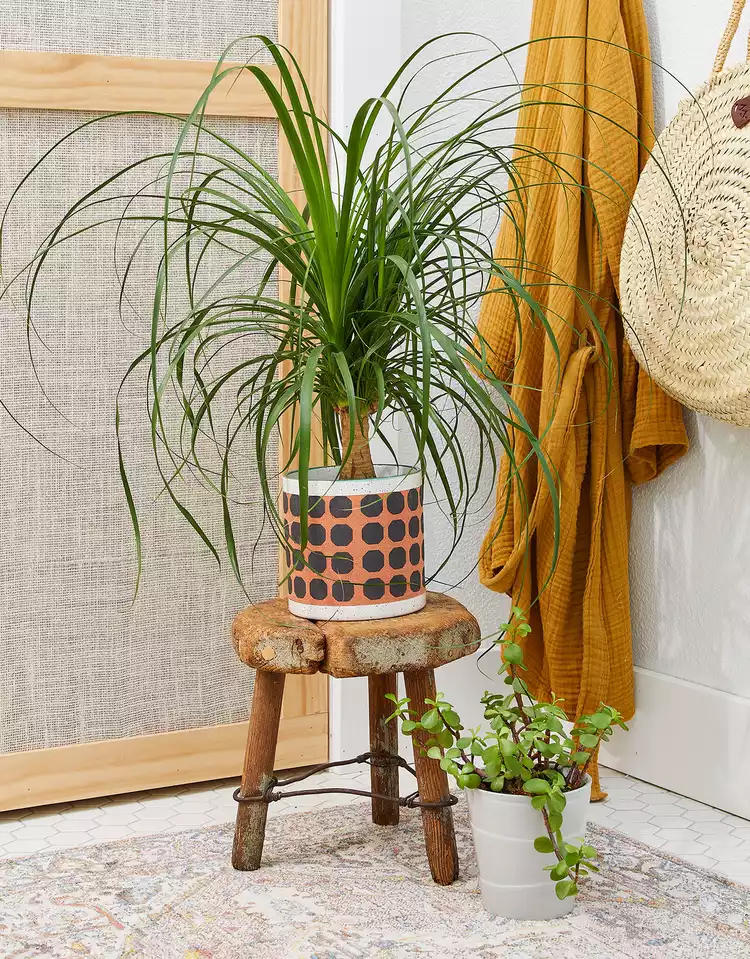5 Tough Indoor Plants That Can Survive Without Sunlight or Water for Weeks

Maybe you've already accidentally killed a few houseplants, and you'd like to find an ultra easy-care plant. Costa Farms, a wholesale grower of plants, decided to find out if there are any indoor plants that can survive without sunlight or water. How? Well, of course, by leaving several varieties in a dark closet without water for three weeks. Five plants made it through the challenge still looking fabulous. No plant is bulletproof, but these varieties clearly don't mind low light (or periods without light), a few missed waterings, or low humidity. Give one of these tough houseplants a try and you may find it nearly impossible to kill.
1. Ponytail Palm
Long, grasslike leaves atop a bare stem give ponytail palm (Beaucarnea recurvata) a palm tree-like appearance that makes it a true statement plant. A type of succulent rather than a palm, it stores water in its thick trunk, which enables it to go long periods without moisture. While ponytail palm can survive without sunlight for short periods, it will do best if you place it in bright light and water it whenever the soil feels dry.
Ponytail palm's roots don't run deep. Plant it in a shallow pot, with the majority of the bulbous base emerging from the soil.
2. Sago Palm
Feathery, dark green leaves on top of a short stem give sago palm (Cycas revolata) a bold texture. Often wider than it is tall, sago palm adds a tropical touch to all kinds of design styles. Despite its name and appearance, it's not a palm tree, but rather a cycad, an ancient plant dating to prehistoric times. Grow it in low to bright light and add water only when the soil feels dry to the touch; it grows slowly, but is a true survivor of a plant.
Pet parents should avoid sago palm or place it well out of reach of curious pets because all parts of the plant are toxic to cats and dogs (as well as humans).
3. ZZ Plant
Thanks to its dark green, glossy leaves, you might mistake ZZ plant (Zamioculcas zamiifolia) for a faux plant. The leathery foliage is not only part of this plant's beauty, but also contributes to its toughness. The leaves seal in moisture, making the plant very tolerant of dry conditions. It also stores water in its bulb-like roots, and only needs to be watered when the soil feels dry. ZZ plant is a good pick for an office, because it can survive without much sunlight and does just fine under fluorescent lights.
ZZ plants can be easily propagated in number of ways—from stem cuttings, leaf cuttings, or by division (the fastest method).
4. Snake Plant
Stiff, upright leaves make snake plant (Sansevieria trifasciata) a popular choice that goes well with just about any decor style. Larger snake plants work well as a floor plant in a dim corner. The smaller varieties make stunning accent plants on a tabletop. Snake plant does best in bright light, but still will grow without much sunlight It's not demanding when it comes to water, either. Just give it a drink whenever the top inch of soil feels dry to the touch.
Snake plants are toxic to cats and dogs so keep them out of reach of your pets.
5. Chinese Evergreen
With patterned leaves splashed or speckled with silver, gold, red, or cream, Chinese evergreen (Aglaonema spp.) is at home just about anywhere. Exceptionally tolerant of low light, it will even survive in spots without much sunlight, such as an interior office. It will also grow in shady spots in the garden. Water Chinese evergreen when the soil is dry to the touch.
The leaves and stems of Chinese evergreens are toxic to humans and pets, so pet owners should avoid the plant or place it out of reach of cats and dogs.